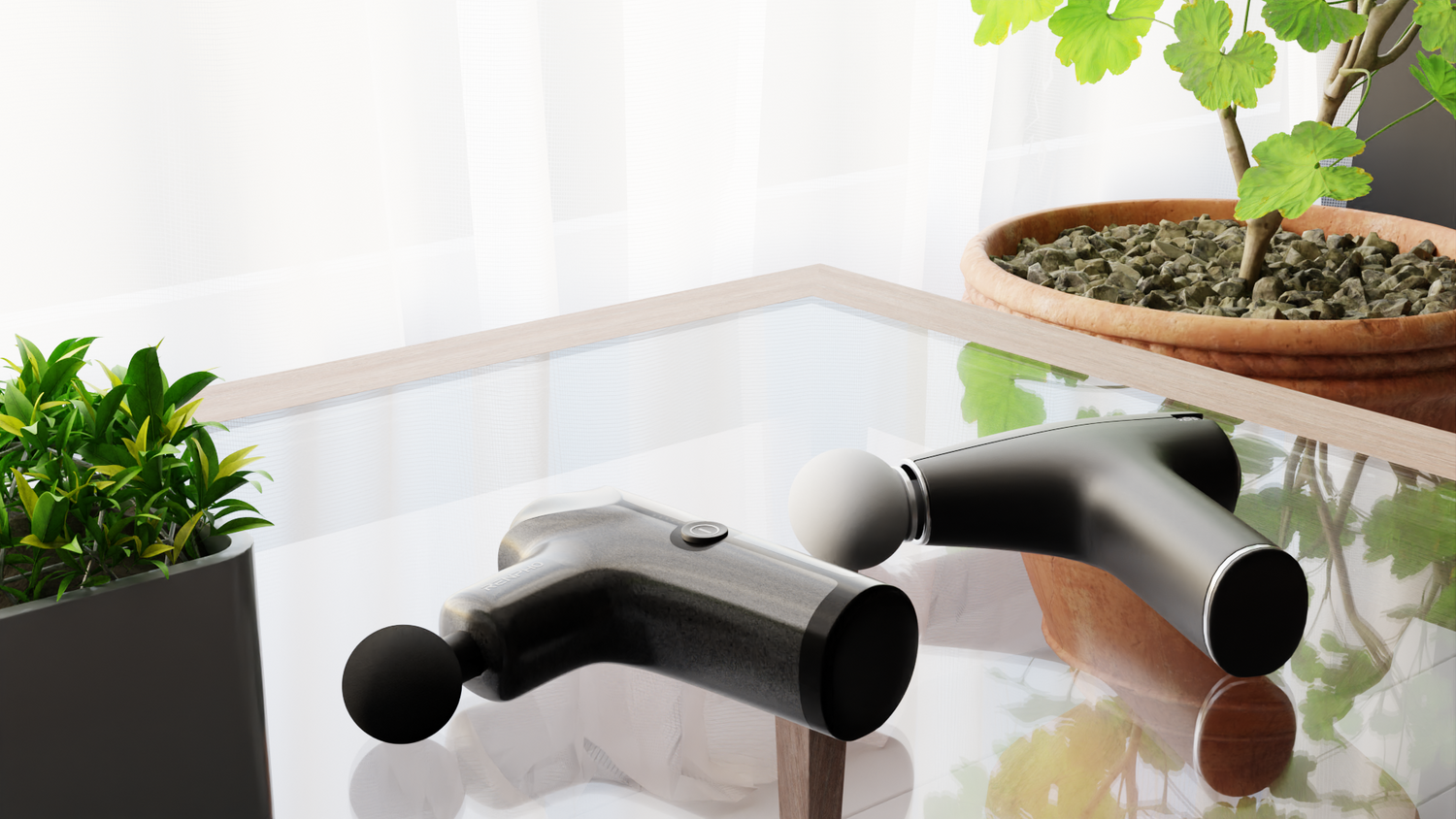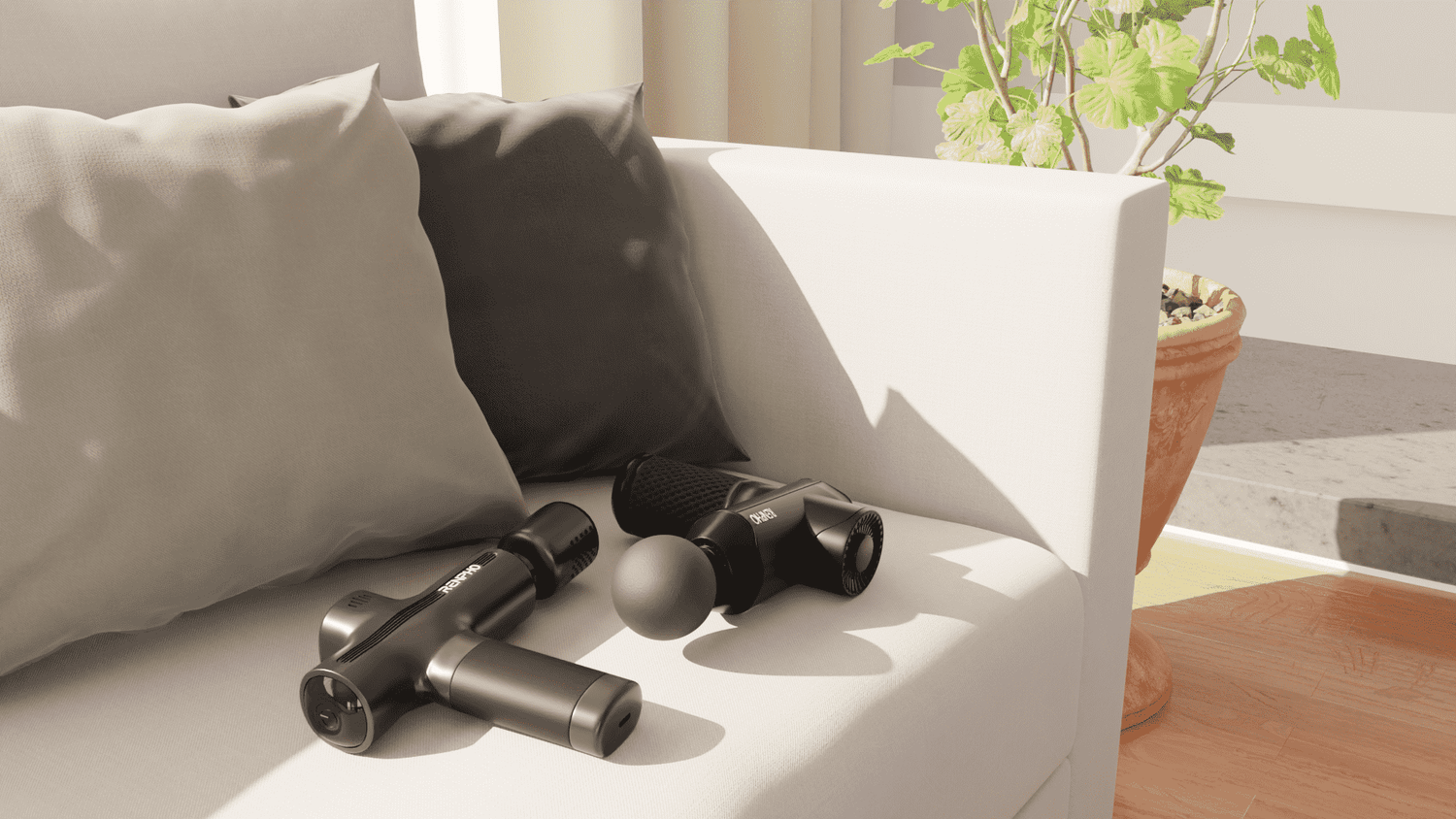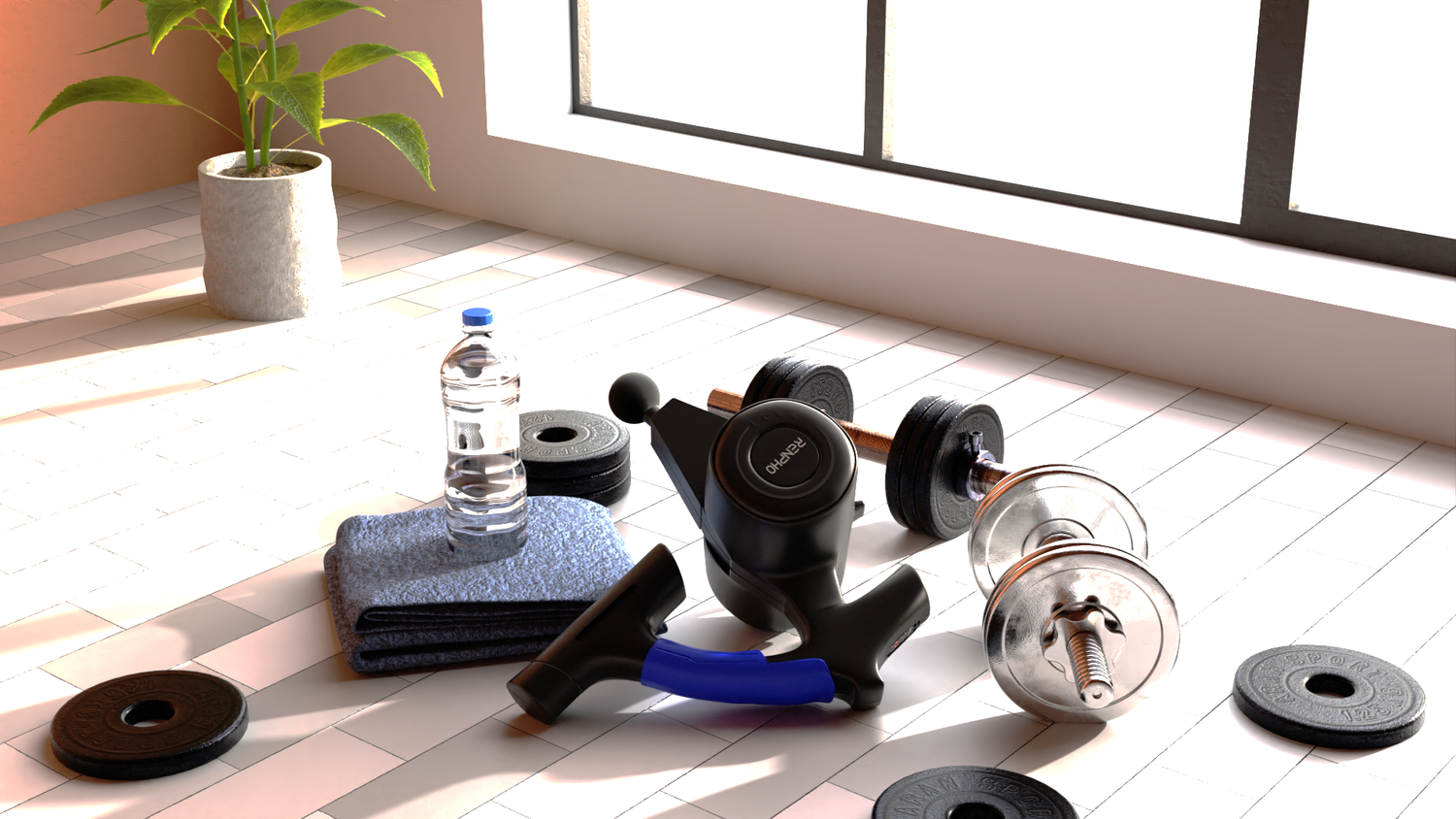How to Use a Massage Gun on Legs: Tips for Relief and Recovery

Stay tuned to our latest news
As we all know, intense physical activity can often lead to muscle tightness and soreness. That's where a massage gun comes in—a powerful tool designed to help alleviate the discomfort.
By incorporating a massage gun into your leg recovery routine, you can enhance blood circulation, reduce muscle tension, and accelerate the healing process. But how exactly should you use a massage gun on your legs?
In this blog, we’ll guide you step-by-step on how to effectively use a massage gun on your legs. From understanding the advantages and safety precautions to selecting the right techniques and targeting specific muscle groups, we've got everything you need to know.
Let's dive in and discover how to use a massage gun on your legs for maximum recovery. Get ready to enhance your leg recovery routine with a new level of relief, rejuvenation, and enhanced performance.
What Exactly is a Massage Gun?
Massage guns are portable, handheld devices equipped with powerful motors that can deliver bursts of pressure and vibration. They resemble the shape of a power drill and sometimes even sound like one. Most massage guns are wireless, relying on a rechargeable battery, and have interchangeable attachments.
A massage gun is often used in “percussive therapy” (also known as “percussive massage treatment” or “vibration therapy”). Percussive therapy is a way of massaging through continuous tapping to create vibrations within your muscles, promoting relaxation and relief. A massage gun delivers these targeted taps to loosen and relax tense muscles. It moves at a high speed with a small, adjustable range of motion allowing you to use it for your specific needs - whether to enhance recovery, relieve pain, release tension, or improve your range of motion. Overall it is a powerful tool useful for improving performance while reducing muscle soreness.
Benefits of Using a Massage Gun on Legs
When it comes to relieving muscle pain in the legs, a massage gun can really make a difference. Leg pain or tightness can arise from various causes, including strenuous leg day workouts or the strain of sitting for long periods at a desk or in front of the TV.
A massage gun is the optimal tool to use to relieve muscle tightness and soreness after exerting the muscles for an extended period of time. The rapid, pulsating strokes loosen the tight muscle fibers and break down muscle knots. These are the painful areas where the muscle stays tight and pinches blood flow, often leading to soreness. In addition, the percussion or vibration therapy applied to the targeted muscle will boost the blood flow and carry more oxygen and nutrients into the muscle cells, speeding up the recovery and easing overall pain.
Not only is a massage gun a great remedy for tired, aching muscles, it is also helpful when warming up. Many athletes and fitness enthusiasts who want to optimize muscle health use the massage gun to loosen tight muscles in their legs before exercising. This temporarily improves the range of motion for their legs, allowing for better performance as well as preventing muscle injuries. Beginners can also benefit from greater flexibility in leg muscles and enjoy their workouts or exercise to the fullest.
Moreover, its convenience cannot be overstated. Portable and easy to use, it eliminates the need for frequent physio therapy visits, putting muscle recovery directly in your control. Whether battling post-run soreness or everyday strain, the massage gun ensures your legs feel rejuvenated and ready for action.
Safety Tips for Effective Massage Gun Use on Legs
Using a massage gun properly can help reduce muscle pain, improve flexibility, and speed up recovery after workouts. However, it’s important to understand the dos and don’ts of using one on your legs to avoid injuring yourself. By following the tips below, you can make the most out of your massage gun.
- Identify the Area(s) of Tension
Just as you use a massage gun on your body, it's important to first identify the specific areas on your legs that feel sore or tight. For this task, you can move your legs around and pay attention to any sensations. For instance, is there a spot that feels particularly tight or less flexible? Or is your movement somewhat restricted and causing discomfort?
Another easy way to find the right spot is to put your hand on different areas of your legs (such as quadriceps, hamstrings, calves, etc.) and press gently to see if they feel harder, knotted, or tender compared to the surrounding tissue. However, take note of any open wounds or irritation in the legs. Don’t use the massage gun on them.
Once you've pinpointed the general region of soreness, press the head of the massage gun against it. Look for the area with the most bulk and the least bony prominence, as this is likely where the tension is concentrated.
- Start Low and Slow
When using a massage gun, it is important to start with the lowest intensity setting to prevent any discomfort or muscle injury. Begin by gliding the device over the muscle and paying attention to your body. If you feel any pain, irritation, or discomfort, stop immediately. Otherwise, you can gradually increase the percussion speed and intensity as you prefer.
It is crucial to allow your body and muscles to adjust to the pressure and cycle through stronger settings to reach the desired effect. By starting low and slow, you can ensure that your muscles have time to adapt to the massage gun and prevent any potential harm. For instance, breaking the blood vessels and inflammation, and bruising by pounding too much with high-intensity pressure.
Find the spot, always listen to your body and adjust the intensity based on your comfort level. Using a massage gun on the legs can be beneficial for relaxing and releasing tension in the muscles, but consider using it safely and responsibly.
How to Use a Massage Gun on Your Legs

- Hamstring Massage
Hamstring muscles are three thigh muscles located between the hip and the knee at the back of your thighs. You use them to perform leg movements. Pain or injury in them is common, especially for people who play sports involving sprinting, such as track, soccer, and basketball.
Even for non-athletic individuals, hamstring injuries can occur due to prolonged activities like walking, dancing, or climbing, especially if there is a muscle imbalance between the quadriceps and hamstrings.
It’s best to use the ball attachment on the hamstrings. It is capable of targeting curves in muscles in this part. Lie on your back with your legs bent and your feet flat on the floor. From here, you can start using your massage gun. Start on top with the lowest settings, then slowly go down in circles. Be sure to move the device slowly along the hamstring, focusing on any tender areas.
- Quadriceps Massage
The quadriceps is a large muscle group located at the front of your thigh. It helps us to control the knee and lift our legs. When the quadriceps muscles are overworked from movements like jumping, running, or weight lifting, they become tight and exert imbalanced tension at the joints. In addition, sitting for a long time also can cause tightness in the quadriceps.
To perform a quadriceps massage using a massage gun, start by sitting or lying down in a comfortable position. Begin by slowly moving the massage gun up and down the front of the thigh, from just above the knee to the hip.
Use the massage gun on a low to moderate intensity setting if the massage is for regeneration purposes, focusing on releasing tension and promoting blood flow to the muscles. If the massage is for activation, a higher intensity setting can be used to help warm up and stimulate the quadriceps.
- Adductors Massage
The adductors are a group of muscles that primarily help with bringing your leg toward the center of your body, moving it closer to the other leg, and assisting in rotating your thigh inward at the hip. Located along the inner thigh, these muscles play an important role in everyday activities by stabilizing your knee as you walk, keeping it from moving outward. This is especially noticeable during activities like biking or swimming.
To perform an adductor massage, start in a cross-legged or foot-on-knee position so you can reach the inner thigh. Start by setting the massage gun at a low-intensity pressure then work the inner thigh from the knee to the hip. Apply gentle pressure and, while in slow, sweeping motions, massage the adductors. Make sure to cover the entire area of the inner thigh to effectively release tension and promote flexibility.
- Shin Massage
The shin is the area at the front of the leg below the knee, and the muscle in it is called the tibialis anterior muscle. This muscle plays a crucial role in walking by contracting to ensure each step is smooth, preventing the foot from slapping the ground.
Some common causes of shin injuries are sudden increases in physical activity, improper footwear or having flat feet or abnormal rigid arches. One thing to be mindful of is hiking downhill, as the downward slope places excessive strain on the muscles through eccentric contractions, leading to soreness.
To perform a shin massage, start by sitting down and positioning the tool along the muscles outside the shin bone, from the ankle to the knee. Use the massage gun and low-intensity pressure going up and down the muscles, focusing on any tight or tender areas. Adjust the massage level gradually, increasing as needed.
- Calf Massage
The calf muscle is located at the back of your lower leg, between the knee and ankle. It helps you stand, move your feet, jump, flex your foot, and rotate your ankle.
Before using a massage gun on your calves, you can warm up the area first. This helps prepare your muscles and can reduce the discomfort you may feel in the process. Do a few things like light stretching and calf or ankle raises.
After the warm-up is done, start by placing the massage gun on your calves, turning it on and setting it to low pressure. Focus on areas that are particularly tight or sore, then move it in a circular motion. Repeat 2x and move 30 - 60 seconds on the area. Then cool down to reduce tension and promote recovery.
How Often to Use a Massage Gun on Your Legs

The frequency of using a massage gun on your legs can depend on several factors such as your level of physical activity, muscle tightness, and overall performance goals. Generally, it is recommended to use a massage gun on your legs 2-4 times per week, especially after intense workouts or long periods of sitting or standing.
For different muscle groups in the legs, the ideal application time can vary. Larger muscle groups like the quadriceps and hamstrings may benefit from 2-3 minutes of massage per area, while smaller muscles like the calves may require less time. It is important to listen to your body and adjust the frequency and application time based on your individual needs and comfort level.
In conclusion, using a massage gun on your legs 2-4 times per week with 2-3 minutes of massage per muscle group can help improve muscle recovery, reduce muscle soreness, and enhance overall performance. But always remember to consult with a healthcare professional before starting any new massage therapy routine.
Choosing the Right Attachment for the Leg Massage
You might think of a massage gun as a simple power drill that pounds muscles, but there is much more to it. Massage guns often come with interchangeable heads that are suitable for different muscle groups.
There are several types of massage gun attachments, including the ball, flathead, bullet, fork, thumb, cushion, wedge, and cone attachments, just to name a few. However, not all of them are ideal for leg muscles. To help to choose the right one to use a massage gun on legs with, we put together a list of suitable attachments.
Ball-Shaped Attachment
The ball-shaped attachment is usually made of rubber or silicone. It is ideal for larger muscle groups, as its round shape allows for even pressure distribution, which helps to target deeper layers of muscle tissue. You can use it for areas like the hamstrings and calves.
Flathead Attachment
The flathead attachment is your all-around tool. This one spreads the pressure out evenly, making it perfect for covering wide areas. It's great for bigger muscle groups like your quadriceps, hamstrings, and adductors for relieving muscle pain and tension. Working on trigger points those tight, sore spots on the legs will loosen up tension, promote relaxation, and speed up the recovery of the muscles.
Heating and Cooling Attachment
A hot and cold therapy attachment takes a massage gun to the next level.
The hot attachment delivers deep heat to muscles, tendons, and ligaments, boosting blood flow, easing stiffness, and helping you relax. It’s perfect for warming up the quadriceps and hamstrings before a workout or soothing soreness afterward.
The cold attachment is all about cooling things down to promote the relaxation of the muscles. It helps reduce inflammation, numb pain, and ease swelling, making it ideal for recovery after an injury or intense exercise.
Using Massage Guns on Legs FAQs
How Can a Massage Gun be Useful in Our Daily Routine?
Your legs work hard everyday, not just during sports but also with everyday activities like walking to the store, standing for long periods while commuting, or walking up and down stairs. Leg muscles are still hard at work when you just sit in the office. Cramps, muscle tightness or muscle pain soon follow.
Massage guns are compact and easy to use. They can provide much-needed relief to your leg muscles, whether you have a cramp in your thigh or a sore calf muscle. The relief you will experience will make it easier for you to return to exercise or any activities that involve your leg mobility.
Does a Massage Gun Help Aid Leg Muscle Recovery?
Indeed, it does. Massage guns speed up muscle healing by increasing blood flow and easing tense muscles. By using a massage gun, you can stimulate the muscle with its deep, percussive therapy. When it vibrates on the muscle area, it promotes blood circulation that could help in muscle recovery.
What are the Best Techniques for Using a Massage Gun on the Legs?
Here are some techniques to make the best out of the massage gun:
- Long Strokes
To effectively target the leg muscles, begin with long, sweeping strokes that cover the entire length of the muscle, moving smoothly from the top of your thigh down toward your knee. These extended motions help warm up the tissue, improve blood circulation, and prepare your muscles for more intense, focused work by ensuring an even, thorough activation of the muscle fibers.
- Circular Motions
Focus on specific muscle groups with circular motions to promote a better supply of nutrients and oxygen in the muscle part. This method digs deeper and works wonders on tight, stubborn spots.
- Trigger Points Release
Find those tight muscle knots, known as trigger points, and press the massage gun directly on them. Hold it there for 15–30 seconds to help loosen things up and ease the tension. The flat or ball attachment works great for this.
Unlock Your Potential with Different Renpho Massage Guns and Feel the Difference
Discover the possibilities with Renpho massage guns, a cutting-edge line of devices that blend modern technology with user-friendly features, making self-care simple and effective.
Renpho massage guns are designed to provide unparalleled relief, tailored to your daily activities and lifestyle. Take, for example, the Mini Thermal Massage Gun—a compact yet powerful pocket-sized solution that delivers instant muscle relief wherever you go. With its heat-conductive steelhead, it heats up to 46℃/114°F in just one minute, soothing deep tissues and reducing tension after workouts or long days. Perfect for both athletes and those seeking relaxation, this device seamlessly fits into your routine.
For enhanced recovery, the Power Thermacool Massage Gun combines both heat and cold therapy with a deep tissue massage, ensuring effective relief for athletes and sports enthusiasts tackling post-activity strain.
With its ergonomic design, the Renpho Reach Massage Gun excels in effortlessly deep tissue massages for hard-to-reach areas, making it a versatile addition to any wellness routine. From recovery to relaxation, this cutting-edge tool empowers you to feel your best every day.
Reclaim your well-being and experience the difference in every session.
References:
https://fusion-recovery.com/blogs/improve-performance/massage-gun-attachments
https://www.donnerberg.net/en/blogs/all-posts/massage-gun-attachments-your-guide-to-proper-use
Renpho Health Tips
-

Can a Percussion Massage Gun Alleviate Back Pain?
January 17, 2024
Read more >
-

Why You Should Get a Heated Massage Gun ASAP
January 15, 2024
Read more >
-

Here's Why Mini Massage Guns Are Worth It Despite Their Size
January 15, 2024
Read more >
-

How a Fascial Gun Can Boost Your Workout Performance
January 12, 2024
Read more >
-

When to Use a Deep Tissue Massage Gun for Optimal Workout Results
January 11, 2024
Read more >





